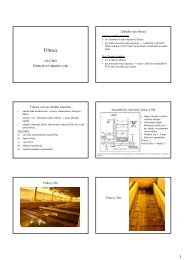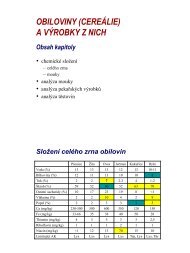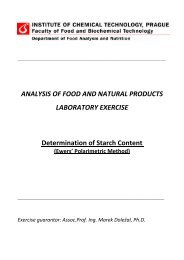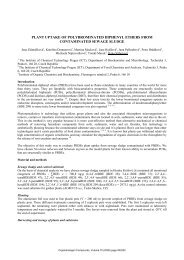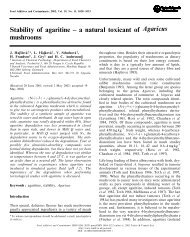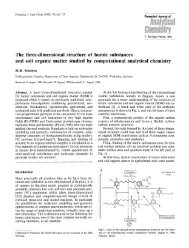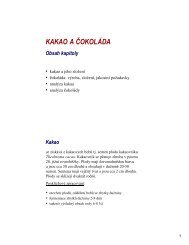Handbook of Food Analysis Instruments
Handbook of Food Analysis Instruments
Handbook of Food Analysis Instruments
You also want an ePaper? Increase the reach of your titles
YUMPU automatically turns print PDFs into web optimized ePapers that Google loves.
TABLE 7.1<br />
Expan sion Vol ume <strong>of</strong> So lvents Used in GC<br />
Solvent<br />
1 mL at 2508C<br />
and 69 kPa (10 psig)<br />
To overcome, or at least partly compensate for these problems, pulsed splitless injection can be<br />
applied. Increased column head pressure for a short period during the sample injection (usually 1–2min)<br />
leads to a higher carrier gas flow rate through the injector (8–9 versus0.5–1 mL=min during classical<br />
splitless injection), thus faster transport <strong>of</strong> sample vapors onto the GC column. In this way, the residence<br />
time <strong>of</strong> analytes and, consequently, their interaction with active sites in the GC inlet is fairly reduced [3].<br />
The detection limits <strong>of</strong> troublesome compounds obtained with pulsed splitless injection are thus lower<br />
and their further improvement can be obtained by injection <strong>of</strong> higher sample volumes (for most liners up<br />
to 5 mL) without the risk <strong>of</strong> backflash (Table 7.1) [4]. It should be noted that for injections > 1–2 mL, a<br />
retention gap prior to the analytical column is generally required to avoid excessive contamination <strong>of</strong><br />
separation column and peak distortion (Figure 7.3).<br />
7.2.2 C OLD ON-COLUMN INJECTION<br />
Expansion Volume (mL)<br />
1 mL at 2508C<br />
and 345 kPa (50 psig)<br />
5 mL at 2508C<br />
and 345 kPa (50 psig)<br />
Water 1414 540 2700<br />
Methanol 631 241 1205<br />
Acetonitrile 487 186 929<br />
Acetone 347 133 663<br />
Ethyl acetate 261 100 498<br />
Toluene 241 92 460<br />
Hexane 195 75 373<br />
Isooctane 155 59 295<br />
Source: From Hewlett-Packard FlowCalc 2.0 s<strong>of</strong>tware. Available at http:==www.chem.agilent.<br />
com=cag=servsup=users<strong>of</strong>t=files=GCFC.htm via the Internet. Accessed July 1, 2007.<br />
Note: Calculated using Hewlett-Packard FlowCalc 2.0 s<strong>of</strong>tware.<br />
In COC injectio n, a sample aliq uot is directly introduced by a speci al syri nge onto the analyt ical<br />
colum n or a reten tion gap at tem peratures lower (608 C –80 8C) than those typicall y used in hot<br />
Pulsed splitless Pulsed splitless<br />
3 µL<br />
4 µL<br />
2 µL<br />
1 µL<br />
Splitless 1 µL<br />
(A) (B)<br />
FIGURE 7.3 Peak shapes obtained by pulsed splitless injections <strong>of</strong> different volumes <strong>of</strong> standard solution<br />
onto the GC column (A) without a retention gap; (B) with an installed retention gap. (Reproduced from Godula,<br />
M., Hajslova, J., and Alterova, K., J. High Resolut. Chromatogr., 22, 395, 1999. With permission.)<br />
ß 2008 by Taylor & Francis Group, LLC.<br />
5 µL<br />
3 µL<br />
2 µL<br />
1 µL



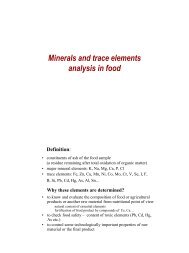
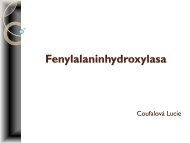
![Legislativa - Označování potravin [režim kompatibility]](https://img.yumpu.com/15533670/1/190x135/legislativa-oznacovani-potravin-rezim-kompatibility.jpg?quality=85)
